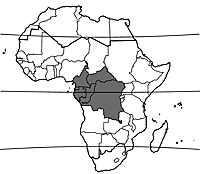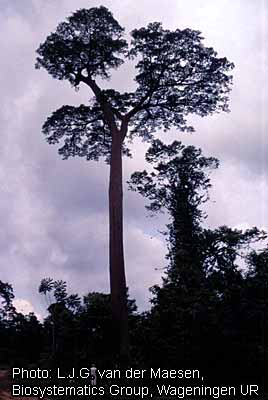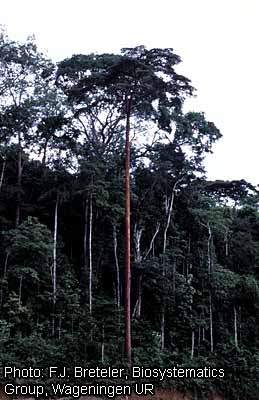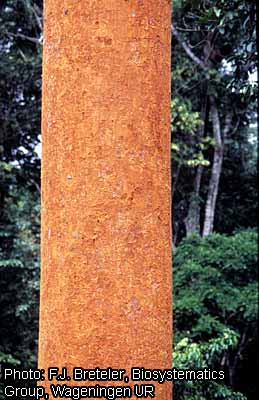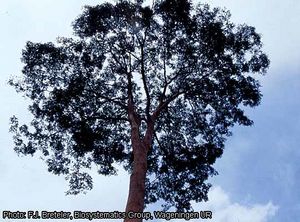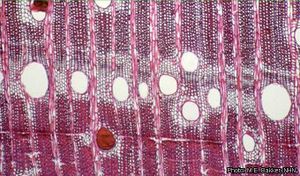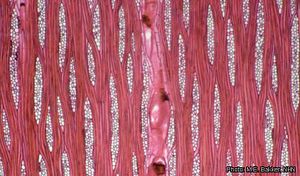Copaifera religiosa (PROTA)
Introduction |
| General importance | |
| Geographic coverage Africa | |
| Geographic coverage World | |
| Essential oil / exudate | |
| Medicinal | |
| Timber | |
| Fuel | |
| Fibre | |
Copaifera religiosa J.Léonard
- Protologue: Bull. Jard. Bot. Etat 19: 398 (1949).
- Family: Caesalpiniaceae (Leguminosae - Caesalpinioideae)
Origin and geographic distribution
Copaifera religiosa is distributed from Cameroon to DR Congo.
Uses
The wood, traded as ‘n’téné’, sometimes also as ‘anzem’, is suitable for light construction, light flooring, joinery, interior trim, vehicle bodies, toys, novelties, boxes, crates, veneer, plywood, hardboard and particle board. It is also suitable as pulp for paper production.
The bark and the resin from the bark and wood are locally used as perfume. The resin is also used in torches and for sealing canoes. In Gabon the bark of young trees is made into boxes used for ritual purposes. In traditional medicine in Gabon bark macerations are taken for the treatment of cough and stomach-ache, bark decoctions for the treatment of cardiovascular diseases, whereas the bark is used in fumigations against headache and kidney pain. Bark preparations are also used to treat malaria. The bark is added to a bath together with other ingredients to treat leprosy. In Cameroon and Gabon the tree is credited with magical properties and used for ritual purposes.
Production and international trade
In the 1960s Gabon and Congo exported small quantities of logs. According to ATIBT statistics, Congo exported 165 m³ of ‘n’téné’ logs in 2006.
Properties
The heartwood is pale brown to red-brown, mottled, turning darker brown upon exposure, and distinctly demarcated from the wide, yellow-white to pale pink sapwood. The grain is straight to slightly interlocked, texture medium to fine, rarely uneven. The wood contains a sticky, transparent resin, and blackish resin ducts are visible. Sawn wood has a bitter, almond-like scent.
The wood is lighter and softer than that of other Copaifera species. It has a density of about 550–750 kg/m³ at 12% moisture content. The wood dries rapidly, with only a slight risk of distortion and checking. During drying, the resin in the wood solidifies and produces whitish clots if the drying temperature is above 70°C. The shrinkage rates are quite low, from green to oven dry 3.8% radial and 4.5% tangential. Once dry, the wood is stable in service. At 12% moisture content, the modulus of rupture is about 117 N/mm², modulus of elasticity 10,000 N/mm², compression parallel to grain 46 N/mm², cleavage 21 N/mm and Chalais-Meudon side hardness 2.3.
The wood saws well, with only slight blunting effects on saw teeth and cutting edges. It works well with most tools and usually planes well, although irregular grain may sometimes cause problems when machine tools are used. It peels well. The gluing properties are good. Varnishing and painting may be difficult because of the presence of resin. The wood is moderately durable, being resistant to Lyctus beetles but liable to attacks by fungi, termites and marine borers. The heartwood is extremely resistant to impregnation with preservatives, the sapwood moderately resistant.
The wood contains 43% cellulose, 29% lignin, 17% pentosan and 0.8% ash. The solubility is about 4.0% in alcohol-benzene, 3.0% in hot water and 18.6% in a 1% NaOH solution.
Bark and roots contain tannin. A dichloromethane bark extract has shown in-vitro antiplasmodial activity against Plasmodium falciparum, while the methanol extract was inactive. The dichloromethane bark extract also showed considerable in-vitro cytotoxicity.
Description
- Large tree up to 45 m tall; bole branchless for up to 30 m, straight and cylindrical, up to 200 cm in diameter, thickened at the base, without buttresses; bark surface smooth or finely scaly, orange to reddish brown, inner bark fibrous, brittle, pale yellow, aromatic; crown umbrella-shaped; twigs short-hairy but soon becoming glabrous.
- Leaves alternate, pinnately compound with 10–16 leaflets; stipules minute, early caducous; petiole and rachis 10–20 cm long, grooved above; petiolules 2–5 mm long, twisted; leaflets alternate, oblong to elliptical or obovate, 2.5–6.5 cm × 1.5–3.5 cm, base slightly asymmetrical and rounded or cuneate, apex rounded to notched, leathery, nearly glabrous, with translucent dots, pinnately veined with c. 20 pairs of lateral veins.
- Inflorescence an axillary raceme up to 19 cm long, with spike-like branches 2(–6) cm long, densely hairy.
- Flowers bisexual, zygomorphic, white, nearly sessile, with 2 small, caducous bracteoles; sepals 4, ovate-lanceolate, c. 4 mm × 2–3 mm, 1 broader than other 3, densely hairy; petals absent or sometimes 4 present and then 1–2 mm long; stamens 8–10, free, c. 5 mm long; ovary superior, sessile, hairy at base and sides, 1-celled, style c. 3 mm long.
- Fruit an ellipsoid to nearly globose pod 3–5 cm × 2–3.5 cm, slightly flattened, leathery, rough, glabrous to hairy, blackish, somewhat shiny, covered with small resin droplets, dehiscent with 2 valves, 1-seeded.
- Seeds oblong, with a red aril.
Other botanical information
Copaifera comprises about 40 species, of which about 35 occur in tropical America, 4 in Africa and 1 in tropical Asia. Copaifera seems closely related to Baikiaea, Detarium, Sindora and Tessmannia.
Ecology
Copaifera religiosa occurs very scattered in dense primary lowland rainforest. It is found on well-drained localities and avoids swampy or temporarily inundated sites.
Management
In Gabon the minimum bole diameter allowed for harvesting is 70 cm.
Genetic resources
It is unknown to what extent Copaifera religiosa is threatened with genetic erosion. In Cameroon it is considered a vulnerable species, because it has a limited ecological range and occurs in regions where forest land is being converted in land to be used for other purposes.
Prospects
The wood of Copaifera religiosa is lighter and softer than that of other Copaifera species, and only moderately durable. Therefore its range of potential uses is limited. Small amounts of its timber are traded on the international market, but it is not known for which end-use. Information on the use of the timber in tropical Africa is also lacking, but the tree is locally used as a source of resin (used for perfume, sealing and as fuel) and various medicines from the bark.
Major references
- ATIBT (Association Technique Internationale des Bois Tropicaux), 1986. Tropical timber atlas: Part 1 – Africa. ATIBT, Paris, France. 208 pp.
- Aubréville, A., 1970. Légumineuses - Césalpinioidées (Leguminosae - Caesalpinioideae). Flore du Cameroun. Volume 9. Muséum National d’Histoire Naturelle, Paris, France. 339 pp.
- Bolza, E. & Keating, W.G., 1972. African timbers: the properties, uses and characteristics of 700 species. Division of Building Research, CSIRO, Melbourne, Australia. 710 pp.
- Lekana-Douki, J.-B., Oyegue Liabagui, S.L., Bongui, J.B., Zatra, R., Lebibi, J. & Toure-Ndouo, F.S., 2011. In vitro antiplasmodial activity of crude extracts of Tetrapleura tetraptera and Copaifera religiosa. BMC Research Notes 2011, 4: 506. 5 pp.
- Vivien, J. & Faure, J.J., 1985. Arbres des forêts denses d’Afrique Centrale. Agence de Coopération Culturelle et Technique, Paris, France. 565 pp.
Other references
- ATIBT (Association Technique Internationale des Bois Tropicaux), 2007. Statistiques. La lettre de l’ATIBT 26: 38–52.
- Costa, J.A.S., 2009. A new combination in the genus Copaifera (Leguminosae). Neodiversity 4: 14–15.
- de Saint-Aubin, G., 1963. La forêt du Gabon. Publication No 21 du Centre Technique Forestier Tropical, Nogent-sur-Marne, France. 208 pp.
- Koumba Madingou, N.O., Souza, A., Lamidi, M., Mengome, L.E., Eyele Mve Mba, C., Bading Bayissi, Mavoungou, J. & Traore, A.S., 2012. Study of medicinal plants used in the management of cardiovascular diseases at Libreville (Gabon): an ethnopharmacological approach. International Journal of Pharmaceutical Sciences and Research 3(1): 111–119.
- Neuwinger, H.D., 2000. African traditional medicine: a dictionary of plant use and applications. Medpharm Scientific, Stuttgart, Germany. 589 pp.
- Normand, D., 1950. Note sur les bois de Guibourtia arnoldiana et de Copaifera religiosa du Mayumbe. Bulletin du Jardin botanique de l'Etat a Bruxelles 20(1): 19-30.
- Raponda-Walker, A. & Sillans, R., 1961. Les plantes utiles du Gabon. Paul Lechevalier, Paris, France. 614 pp.
- Sallenave, P., 1955. Propriétés physiques et mécaniques des bois tropicaux de l’Union française. Centre Technique Forestier Tropical, Nogent-sur-Marne, France. 129 pp.
- Volavka, Z., 1998. Crown and ritual: the royal insignia of Ngoyo. University of Toronto Press, Toronto, Canada. 411 pp.
- Wilczek, R., Léonard, J., Hauman, L., Hoyle, A.C., Steyaert, R., Gilbert, G. & Boutique, R., 1952. Caesalpiniaceae. In: Robyns, W., Staner, P., Demaret, F., Germain, R., Gilbert, G., Hauman, L., Homès, M., Jurion, F., Lebrun, J., Vanden Abeele, M. & Boutique, R. (Editors). Flore du Congo belge et du Ruanda-Urundi. Spermatophytes. Volume 3. Institut National pour l’Étude Agronomique du Congo belge, Brussels, Belgium. pp. 234–554.
Author(s)
- M. Brink, PROTA Network Office Europe, Wageningen University, P.O. Box 341, 6700 AH Wageningen, Netherlands
Correct citation of this article
Brink, M., 2012. Copaifera religiosa J.Léonard. [Internet] Record from PROTA4U. Lemmens, R.H.M.J., Louppe, D. & Oteng-Amoako, A.A. (Editors). PROTA (Plant Resources of Tropical Africa / Ressources végétales de l’Afrique tropicale), Wageningen, Netherlands.
Accessed 1 June 2025.
- See the Prota4U database.

